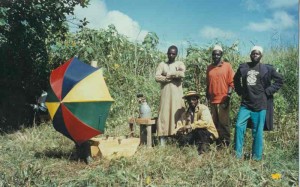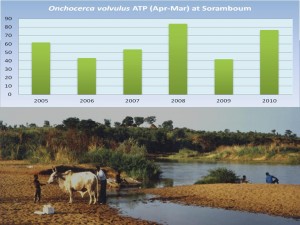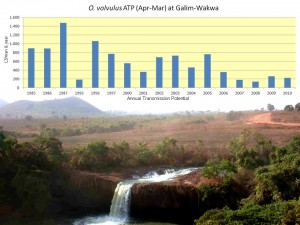Programme Onchocercoses began over 35 years ago in cooperation with African colleagues in Cameroon.
In February 1976, field work started in the area of Touboro, where human onchocerciasis was hyperendemic in those villages, which were situated close to the Vina du Nord. Our aim was to compare the intensity of transmission in villages, showing different degrees of endemicity, with the specific aim to define a ‘tolerable level of transmission without occurrence of severe eye-lesions’. Since only hyper-endemic villages were found around Touboro, the first field-laboratory was set-up in Tcholliré, 200 km NW, near meso- and hypo-endemic villages situated at increasing distances from the Simulium breeding sites in the river Mayo Galké (Mayo Rey).
Later, in 1984, the focus was on the vectors of the forest type of human onchocerciasis. Therefore a new laboratory was set up at the Medical Research Centre in Kumba, SW-Province.
In order to compare the different endemicity in the forest and savanna, and the prepare the first mass-treatment trial with ivermectin in 1987, another field laboratory was established at Soramboum (Campement du Syrien) along the river Vina du Nord.
As the main interest of our research then changed to bovine filariae and to specifically to Onchocerca ochengi in Zebu cattle, our laboratory moved again towards the South: To Ngaoundéré, capital of the Adamaoua plateau, where the first laboratory was set up by PhD-student Goetz Wahl (1988-1992) and the second at the present place in the Quartier Balhadji II since 1996.
Here we give a brief summary on the endemicity of onchocerciasis in various biogeographic regions of Cameroon and on our research topics during the succession of projects over the years from 1976 – 2013

1976-1979: Transmission dynamics of human onchocerciasis in the Sudan savanna
- Field studies in North Cameroon (Tcholliré and Touboro): Parasitological, ophthalmological, ethological and entomological data on the transmission dynamics of human onchocerciasis in Cameroon (WHO/OCP, TDR, CEC): Definition of the critical level of transmission: ATP 100, ABR 100 (WHO/SAP Meeting Geneva 1977), then adapted by WHO/OCP as the criteria for successful operation of OCP in West-Africa.
- Baseline data for mathematical models of onchocerciasis transmission.
- Different exposure behaviour (DVF) explains higher levels of onchocerciasis prevalence in males.
1984-1987: Bionomics of Simulium blackfly-populations in various bioclimatic zones of Cameroon
- Characterization of Simulium vector populations in rainforest and savanna by cytotaxonomy and morphometry. Simulium dispersal and migration pattern and vectorial capacity. Set-up of a large-scale epidemiological surveillance network in the Sudan-savanna (CEC and WHO; PhD-Thesis of Dr. Claus Barthelmess):
- Epidemiological significance of yet unidentified non-human Onchocerca-L3 in man-biting Simulium damnosum s.l..
- Identification of Onchocerca-larvae in anthropophilic Simulium damnosum s.l. by DNA-probes and morphology shows 30 to >90 % prevalence of non-O. volvulus L3 (WHO/CEC/DFG).
- Zooprophylaxis and immunological cross-reaction of O. volvulus and O. ochengi.
1986: Ivermectin masstreatments in the Vina valley
- Initiation of ivermectin mass-treatments in the Vina valley in Cameroon (WHO): Transmission cycles of O. dukei, O. ochengi and O. ramachandrini (n.sp.).
1987-1997: Epidemiological significance of crosstransmission of human and animal Onchocerca-species: zooprophylaxis and premunition
- Bovine onchocerciasis and development of O. ochengi as a model for Onchocerca population biology, chemotherapy and vaccination studies (CEC, WHO): Cattle protect from onchocerciasis – Zooprophylaxis by reduction of Simulium vectorial capacity and cross-protective concomitant immunity by cross-transmission of animal filariae (Onchocerca ochengi; PhD-Thesis of Dr. Goetz Wahl).
- Successful vaccination of calves against O. ochengi by using a heterologeous live vaccine (O. volvulus L3, PhD-thesis of Dr. Daniel AchuKwi).
1992-2000: Onchocerca ochengi, the new bovine model
- Onchocerca ochengi in African cattle as a novel drug-screening model for the search of new macrofilaricidal drugs (WHO/OCT, collab. with Prof. Trees, Liverpool)
- Wolbachiae: First observation of macrofilaricidal action of tetracycline reported to WHO and EDNA (Renz, 1996) and confirmed to be linked to the elimination of Wolbachia-endobacteria.
On-going since 1984: Entomological follow-up of Simulium vector populations and transmission
- Transmission studies before and following ivermectin-mass-treatment (WHO) 19 years of annual mass-treatment with ivermectin insufficient to interrupt transmission. Combined effects of zooprophylaxis and cross-reacting immunity tend to reduce the risk to human population (Dipl. biol. Ralph Seidenfaden).
Since 2000: The biology of Onchocerca ochengi in cattle
- Epizootiology and population dynamics of O. ochengi in cattle (DAAD, WHO)
- Density-dependent regulation of adult worm fertility and microfilarial density.
- Development of appropriate mathematical models of human and bovine onchocerciasis epidemiology.
2002-2004: Co-infections in cattle and their influence of bovine onchocercosis
- Epizootiology of Dermatophilus congolensis (Actinomycetales) in cattle (DAAD, Dipl. biol. Constanze Lay)
- Prevalence of infection and different strains, transmission by ticks and co-infestation with Onchocerca species.
Since 2003: The role of Wolbachia endobacteria
- Biology of endosymbiotic Wolbachiae in Onchocerca filariae and Simulium flies: Electron microscopy and molecular biology (Univ. of Hohenheim, Dipl. biol. Stefanie Plappert). Life cycles and development of intracellular Wolbachiae in different life stages of their hosts.
2007: Development of molecular genetic tools
- Cooperation with Dr. R. Post, British Natural History Museum, on genotyping, detection of microfilariae in the urine, sputum and tears of cattle, cytotaxonomic identifications of Simulium flies.
2009-2012 Start fo new DFG-funded project of German-African partnership
- DFG-German-Cameroonian Cooperation Project in Infectiology: “Analysis of host-parasite cross-talk based on the bovine model for human onchocerciasis, Onchocerca ochengi” (Eva Liebau, Norbert Bratting, Daniel Achukwi, Dieudonné Ndjonka)
- Production of in-vitro excretory-secretore products of L3 and adult Onchocerca ochengi worms for immunology and proteomics.
- Search for the vectors of yet unknown animal filariae (PhD-Thesis of Dipl. biol. Albert Eisenbarth). Only if these vectors and transmission cycles are known, we can estimate how many L3s of the various Onchocerca species are inoculated into one host (game animals, cattle or human being) per year. Though most of them do not develop to the adult stage, the inoculation of homologeous or heterologeous infective larvae may stimulate and eventually immunize the host.
2010 – ongoing: Molecular genetics of O. ochengi populations
- parental affiliation of microfilariae by molecular genetic tools. (Dr. Adrian Streit and Dipl. biol. Julia Hildebrandt, MPI Tübingen). We now can attribute, to one a single microfilaria, her father and her mother. This allows to quantify the proportion of the total microfilarial load in the skin of a cattle, that each female contributes.
The human bait (“fly-collector”), who sits near the river and exposes his legs to catch the Simulium flies, is still the gold standard for measuring Annual Biting Rates and Annual Transmission Potentials of human onchocerciasis. Attempts to develop an automatic trap led to the development of the ‘Magic fly-boy’, a CO2-baited automatic trap with strong visual cues:
This trap catches about as many Simulium damnosum s.l. flies as a human collector. We now also develop an automatic trap which mimics a cattle, see gallery.
Ongoing entomological studies on the decline of Onchocerca volvulus transmission following mass-treatment of the village-populations by the microfilaricide Mectizan (ivermectin)
Our routine fly-catching sites are located in two different bioclimatic zones, in order to follow the expected decline in transmission:
– in the Vina du Nord valley at Soramboum (Campement du Syrien, where we have entomological data since 1976), in an area of hyperendemic Sudan-savanna type of blinding onchocerciasis (see Renz et al. 1987), and –
– at the river Vina du Sud near Wakwa on the Adamaoua plateau, where zooprophylaxis and cross-reacting immunity never allowed human onchocerciasis to become a major public health problem (see Renz et al. 1991 and Wahl et al. 1997).
In both areas, regular fly-catches are made throughout the year. Caught flies are brought into the laboratory in Ngaoundéré, where they are dissected to assess parous rates and filarial infections. Infective L3s are classed, on the basis of their length and morphology, to either O. volvulus, O. ochengi or O. ramachandrini. Furtheron, these L3s are subject to molecular genetic analysis: PCR and sequencing of the DNA.
O. volvulus Annual Transmission Potentials along the river Vina du Nord near Soramboum: Though transmission has declined from values over 1000 L3/man,year to about 100, the risk of on-going transmission is still obvious.
O. volvulus Annual Transmission Potentials along the river Vina du Sud near Wakwa. Definitively, there are still some infective larvae of O. volvulus found in man-biting flies, but the risk for the local population seems to be very low, as shown by low infection rates in the human population and the rare occurrence of eye-lesions. More recent data show, that no more infective larvae of O. volvulus could be confirmed by molecular techniques in man-biting local Simulium flies since 2013.






Leave a Reply
Want to join the discussion?Feel free to contribute!